386 Search Results for complex communication
March 29, 2018
by Carole Zangari -
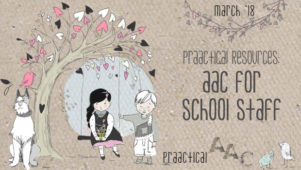
Looking for a learning resource that goes beyond a quick overview and covers some of the details about providing AAC to school-aged children? Today, we visit an online learning site by the UK Department for Education called Communication-Augmentative and Assistive Strategies. It has wonderful information on a variety of AAC topics and downloadable resources for topics such as low tech AAC, vocabulary selection, and becoming a good communication partner. Take your time to explore this learning module and all of the resources it has to offer.
March 19, 2018
by Carole Zangari -
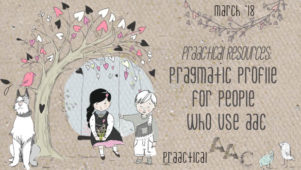
We’ve shared the Pragmatics Profile of Everyday Communication Skills in Children (by Hazel Dewart and Susie Summers) previously, and it remains a very useful tool. More recently, it has been adapted by Suzanne Martin, Katherine Small, and Rachel Stevens to focus specifically on people who use AAC. The Pragmatic Profile for People Who Use AAC is a welcome addition to our AAC assessment toolkit. Many thanks to the ACE Centre for their leadership and support in this area. :::::::::::::::::::::::::::::::::::::::::::::::::::::::::::::::::::::::::
January 18, 2018
by Carole Zangari -
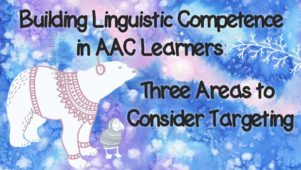
For several years, those who specialize in supporting AAC learners have stressed the need to develop AAC systems and programming that go beyond the communicative function of requesting in order to target the ability to protest, reject, comment, etc. This has been an important trend that will empower users of AAC to express themselves in much fuller ways. What other things should we be targeting in order to help our clients and students become more linguistically competent? Here are some ideas for goal areas to consider. Temporal Markers: While no one can overstate the importance of talking about our current needs, interests, observations, and preferences, we have to be careful not to get stuck in the moment. It is also important for our AAC learners to develop the language skills to be able to talk about things that already happened or that will/might be happening. Why? Among other things, this... [Read More...]
June 19, 2017
by Carole Zangari -
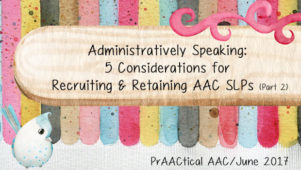
Do any of these situations sound familiar? Janelle, an SLP in an urban elementary school, was flustered when the principal directed her to ensure that her students’ AAC devices didn’t go home on weekends or during school breaks. She hated to see the students lose access to communication during those times but, Janelle understood the principal’s logic. The device had been bought and paid for by the school, and they had to scrounge around to find the funding for it. If it were to get damaged or lost, the school would have to replace it, and there were no funds for that. It was unfortunate, Janelle felt, but, what could she do? Later in the year, when the results of a system-wide audit came out, Janelle’s students were some of the ones identified as having been denied their rights to a Free, Appropriate Public Education (FAPE). Had she known the... [Read More...]
March 23, 2017
by Carole Zangari -
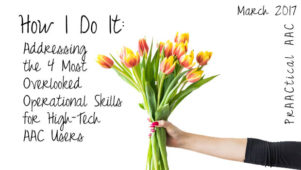
Like many of you, the best part of the work week is when I get to teach language. As amazing as it is to help people with AAC needs become more linguistically competent, we have to be sure not to shortchange some of the operational skills that allow AAC learners to be successful. In this post, SLP Rachel Madel helps us think about supporting the development of operational competence in our AAC learners. The 4 Most Overlooked Operational Skills for High-Tech AAC Users When I first began helping children use high-tech AAC systems, I focused all of my energy on building strong communicators who could navigate through complex systems and use powerful language. I quickly realized that if I wanted to optimize the use of AAC I also needed to teach my students the mechanics of the machines they were using. Once I began teaching basic operational skills, I noticed... [Read More...]
June 28, 2016
by Carole Zangari -
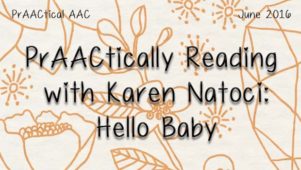
Karen Natoci is back with some wonderful suggestions for reading and building AAC skills with young children. Although her focus is on little ones with visual impairment, these books and the implementation suggestions, would be useful for a wide range babies, toddlers, and preschoolers who are developing their language skills. Enjoy! :::::::::::::::::::::::::::::::::::::::::::::: Books Hello Baby Words (high contrast board books) by Roger Priddy, illustrated by Holly Jackman (Published by St. Martin’s Press, 175 Fifth Avenue, NY 10010) Hello Baby Words: On The Go Hello Baby Words: Faces Hello Baby: Animals Hello Baby: Faces Core Vocabulary Focus: GO, GET, WHO, THAT, SEE, IT Fringe Vocabulary Transportation: digger, balloon, train, roller skates, helicopter, truck, car, submarine, rocket, dump truck, fire truck, boat, race car, tractor, car carrier, plane Animals: cat, turtle, fish, pig, butterfly, cow, mouse, bird, bear, zebra, rabbit, panda, penguin, dog, sheep, snake Faces: boy, girl, woman, man, grandfather, grandmother... [Read More...]
June 1, 2016
by Carole Zangari -
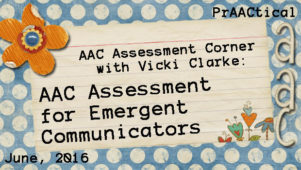
Today, we welcome back Vicki Clarke with more helpful information on conducting AAC assessments. If you work with individual who are at the early stages of communicative development, this post is for you! :::::::::::::::::::::::::::::::::::::::::::::::::::::::::: Some of my most favorite students are those who, at first, may not seem to notice me at all. Sometimes these students seem to exist in their own worlds. They don’t seem to respond in ways we would expect: looking, attending, listening, or gesturing. They may have a diagnosis of Autism, significant developmental delay, epilepsy, or any number of syndromes. I love these kids, and unfortunately, these are often the students who don’t get referred to me. Sometimes it takes years of working in a district before I get to see students with significant developmental delays. These children are typically served in classrooms for students considered to be severe/profound or multi-handicapped. Honestly, I usually get the... [Read More...]
February 25, 2016
by Carole Zangari -
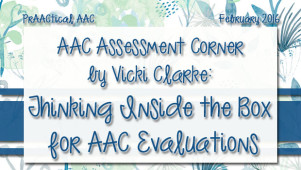
AAC assessment is a challenge in almost every service delivery setting, and many of you have reached out to us to ask for advice on how to strengthen your assessment practices. Luckily, Vicki Clarke, an AAC Chick who has a great deal of experience assessing learners in clinical and educational settings, has tips and resources to share. In this continuation of the AAC Assessment Corner series, Vicki talks about a key feature in any AAC system: vocabulary organization. ::::::::::::::::::::::::::::::::::::::::::::::::::::::::::::::::::::::::::::::::::::::::::::: Thinking Inside the Box for AAC Evaluations: What Type of Vocabulary Organization is Right For Your AAC User? Professionals often spend a great deal of time concerning themselves with which box they should get their AAC user. Should I pick a Prentke Romich or a Tobii Dynavox? But what about the iPad? And what about the money? Should I pick a CheapTalk or a GoTalk instead? Here’s the good news: The box is not the... [Read More...]
February 16, 2016
by Carole Zangari -
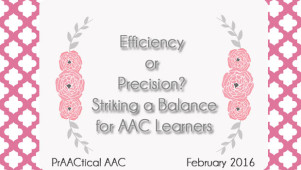
Elliott has been using some form of high tech AAC since he was in kindergarten and can express wants/needs easily. Though his language is simplistic compared to his 5th grade peers, he is able to use his SGD to give opinions, explain them, ask questions, engage in small talk, and tell short narratives. His SLP has targeted skills in inferencing, use of prefixes (‘un’ and ‘re’), verbal reasoning, Tier 2 vocabulary, and embedded clauses to help Elliott acquire the language skills that will allow him to be more successful in his academic work. She is keenly aware that, as he transitions to middle school, the academic and social demands on him will increase significantly. Although Elliott can spontaneously produce 9-12 word sentences, he usually communicates in short, simple utterances. In a recent interaction he used a single word, ‘good,’ to describe a video, and a short sentence (‘I was mad’)... [Read More...]
November 9, 2015
by Carole Zangari -
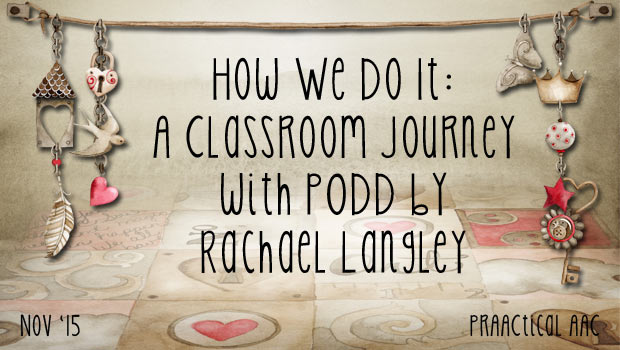
Let’s face it. Good AAC implementation takes commitment and requires a lot of effort from those who are with the AAC learners throughout the day. Sometimes an AAC tool or strategy that seemed promising at first, doesn’t pan out to be as successful as expected. Other times, it’s a challenge to keep up with the demands of the classroom, therapy session, and life and still find the energy to consistently implement good AAC practices. In the real world, teams struggle with these issues every single day. So when Rachael Langley, a Michigan-based SLP and AAC specialist, offered to provide insight into what that process has been like in classrooms she supports, I was thrilled. Rachael’s original post about using PODD in the classroom and her follow-up post on implementation tips gave us insight into the journey that one elementary school classroom team is taking to better serve their students with little or no... [Read More...]









